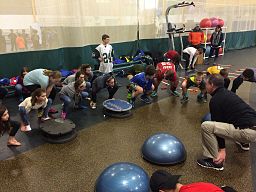Theories for Physical Education on Healthy Eating Habits
 The eating patterns a person has an adult are directly influenced in childhood and adolescence. These habits will promote optimal health, intellectual development, prevent health issues, eating disorders and tooth decay. School health programs such as physical education can help children and adolescents reach their full potential by giving them social support and the reinforcement needed to adopt healthy habits and behaviors in adulthood.
The eating patterns a person has an adult are directly influenced in childhood and adolescence. These habits will promote optimal health, intellectual development, prevent health issues, eating disorders and tooth decay. School health programs such as physical education can help children and adolescents reach their full potential by giving them social support and the reinforcement needed to adopt healthy habits and behaviors in adulthood.
Importance of School Programs
School programs are extremely important in promoting lifelong healthy eating habits. Because a child’s dietary habits contribute to preventable illness and premature death, schools are encouraged to provide nutritional education to children from preschool and up through the 12th grade. The USDAs Nutritional Education and Training Program promotes “nutrition education be a major educational component of all child nutrition programs and offered in all schools, child care facilities and summer sites.”
We’ve all heard that breakfast is the most important meal of the day and skipping it can adversely affect a child’s performance in many different areas. Another issues that needs to be addressed in children is iron deficiency anemia. This type of deficiency causes fatigue, shortened attention span, and decreased work capacity, an increased risk of infection and impairment of their intellectual performance. In order to prevent iron deficiency anemia, children need to eat high iron and vitamin C rich foods.
Obesity and Overweight Children
There is a rise in the number of children who are overweight or suffering from obesity. The commonality being overweight among children ages 6-17 has more than doubled in the past thirty years, most of the increase has happened since the 1970s. Obese and overweight children can suffer from health issues, be bullied and are often excluded from peer groups.
Furthermore, children who are overweight or obese tend to have a poor body image, low self-esteem, experience psychological stress and discriminated against. The Centers for Disease Control guidelines for school is to promote physical activity among youths and to address strategies to increase physical activity among young people in general.
Why is Physical Education Important in Schools?
The importance of a healthy diet and regular physical activity during childhood and adolescence cannot go unsaid. In order to decrease the skyrocketing rates of overweight and obese children, preventative measures should start as early in life as possible. Schools are an important environment to promote healthy lifestyle choices, nutritional education and physical activity.
Schools have a responsibility to help in the prevention of obesity and to promote physical activity and healthy eating in children. These things can be accomplished through policies, practices and supportive environments for children. With diligence and incorporating nutritional education and regular physical activity from a young age, a child can grow up to become a health-conscious adult who stands less of a chance at becoming overweight or obese.
 Eating Disorder Self Test. Take the EAT-26 self test to see if you might have eating disorder symptoms that might require professional evaluation. All answers are confidential.
Eating Disorder Self Test. Take the EAT-26 self test to see if you might have eating disorder symptoms that might require professional evaluation. All answers are confidential.